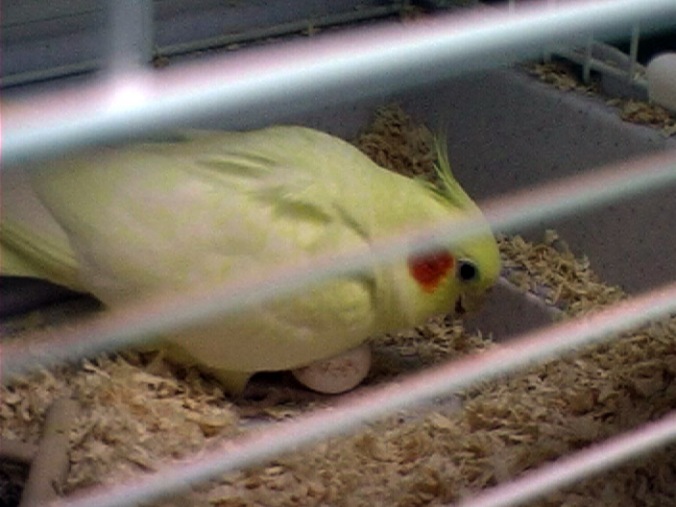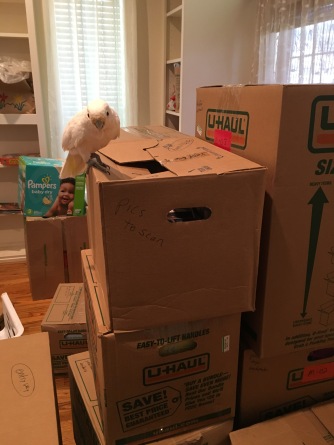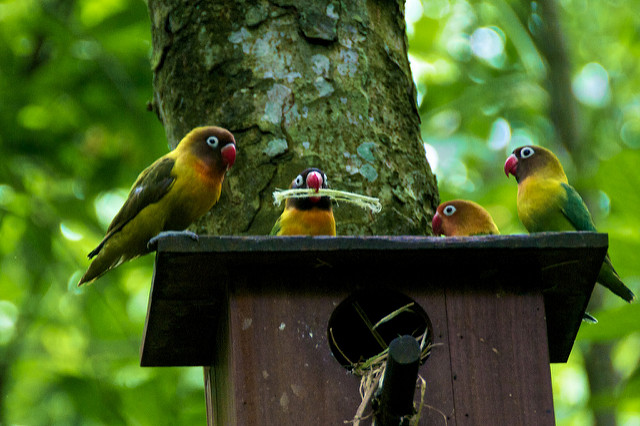Basic Taming
Clip both the wings or have a professional do it for you prior to taming. Once you get the bird home give it about a day to adjust. Taming should be done in a small room without much furniture. Bathrooms, shower stalls, and hallways that can be blocked off work well. The bird should be transferred from the cage to the taming room with as little fuss as possible.
The cage should be completely out of the room. Frightened birds will head for the cage if it is in sight. If you have other birds, the training room should preferably be out of sight and sound of them as well. You basically want an area with you, the bird, the training tools and nothing else. Tools needed for taming include treats, a towel, two wooden dowels (perches) and a something nonthreatening for you do concentrate on (phone, book, tablet, crochet). Millet spray is a great treat for any bird; grapes, nuts and other fruits can be used for larger species.
Lesson 1: I am Not a Predator
The first lesson is designed to demonstrate that you are not some ravenous predator out to kill the bird. The procedure is simple: Place a towel on the floor a few feet away from you and place the treats on it. Place the bird on the floor, sit down, and do your nonthreatening activity while completely ignoring the bird. It will probably move as far away from you as it can. This is why the room must be small- you want the bird in fairly close proximity, not 10 feet away. Feel free to chirp on occasion, but avoid making eye contact. Eating healthy finger foods like carrots or popcorn while you read also helps. Eventually it may get the courage to taste some of the treats, move about, or preen. When the bird starts relaxing around you physically you can start the next lesson.
Lesson 2: Stick Training and the Up Command
The object is to get the bird to step up onto a wooden perch and then a finger. You’ll need two perches that are familiar to the bird. Don’t use anything strange or fancy that could frighten the bird. Wooden dowels from the bird’s cage work well.
Start by holding the perch at the very end and getting the bird to step up on the opposite end. This can take a while. Most birds step up willingly if correctly prompted. The perch should be offered above the feet, slightly lower than mid-chest. Too low or too high and the bird won’t step up. Gently push into the bird to move it off balance, and it should step up. Some birds heroically cling to their current perch, regardless of how off balance they are. You just have to be persistent.
Praise the bird once it steps up correctly, then try again. This time use a word to ask it to step up. “Up” is the standard word, but pick whatever you know you’ll use on a regular basis. I usually fall back on “come here.” Whatever you choose, use it consistently and have anyone else in the household use it as well. Remember to praise the bird profusely after EVERY correct step up.
Eventually the bird should begin stepping up easily when asked. This would be a good place to stop the session, depending on the bird. Some birds get bored with repeated step ups and will simply jump off and head elsewhere. You definitely want to stop before that happens.
Next you want to make the transition from perch to finger. Continue the step ups, but each time slide your hand along the perch a bit closer to the bird. If the bird freaks out move back and inch or two and try later. After a while you should be able to get your finger directly under the bird’s feet while still grasping the perch. At this point you can try switching completely to fingers. Make sure you hold your fingers straight. A crumpled finger isn’t very inviting.
Once the bird is finger trained in the taming room, try it again from the cage. Try to give it something fun to do when it is outside the cage, so it has a reason to come out. A playstand stocked with millet or other healthy treats should work well. If your bird can happily play by itself on a stand with you in the same room then you’ve accomplished a lot. Petting is something people tend to worry about, and it can’t really be trained. Not all birds enjoy being pet, and it’s not something you want to push them into. Cockatiels, cockatoos and conures usually like being pet; budgies don’t. Focus on building a good relationship with your bird. Earning their trust is key.
Types of Untame Birds
Budgies
Unlike most species, budgies don’t usually come handfed. For this reason, budgies are best purchased one at a time. Single birds are much easier to tame than two at a time. Once your first budgie is tame you can buy a second. The first may actually help you tame down the second. Birds watch each other closely, and a frightened bird may relax a bit if it sees a tame bird interacting with you. If you make the mistake of buying two budgies at once they should be separated (sight AND sound) for taming sessions.
The Timid Handfed
No taming problems for you! You wanted a nice friendly bird so you bought a handfed. However, the bird just sits there, not making a sound and avoiding contact. What went wrong?
Chances are that you’ve been tip-toeing around your new bird with the intention of letting it settle in. This is a problem. Birds are prey animals. In the wild they tend to make some level of noise when they feel comfortable. If their environment suddenly becomes silent, it is usually a sign of danger. By avoiding your bird and being as quiet as possible, you are conveying the message that danger is near. There is little in the way of “settling in” that birds need to do. They will need to adjust to their new cage and your daily routine, but that’s about it. Birds are much more adaptable that we give them credit for.
Handfeds need virtually no time to adjust. Don’t avoid them. Instead, immediately talking to them and wait no more than a day to start handling.
Used Birds
These birds usually come with problems. We humans have the tendency to teach our birds all kinds of annoying habits, and then give our pets up when they don’t meet our perception of The Perfect Bird™. I suggest consulting an avian behaviorist for truly troubled birds, as that is beyond the scope of this article. My goal here is to give you a jump start towards building a trusting, civil relationship.
Try to learn as much about your used bird as possible. What did it eat? Was it kept around children or pets? Physically abused? Exposed to toys? Other birds? The answer to each of these questions should influence how you treat your new bird. A bird with limited exposure to children, pets, toys and new foods may show fear at the introduction of any of these. Birds kept isolated from other birds for years probably have no flocking skills, particularly if they’ve been housed with a mirror (mirrors generally make birds antisocial or territorial). In this case you must use extreme caution when introducing it to other birds. A physically abused bird may be very fearful of humans.
Untame used birds are generally either fearful or hostile. A fearful bird will try as hard as it can to get away and will bite if cornered. A hostile bird holds its ground and bites if approached.
 Hostile Birds
Hostile Birds
Given the choice, I’d rather work with a hostile bird. These guys tend to tame down quicker- it’s a simple matter of winning them over while at the same time displaying your authority. Basically you can treat these guys like new birds that just hit puberty and got an attitude. Reinforce the “up” and “down” commands, and give them praise and treats for good behavior. You can also modify the basic taming technique. For instance, a few years ago I adopted a mitred conure who neither liked nor hated people. Fry would grudgingly step up on an arm, but he would not voluntarily interact with humans. I placed him on the back of a chair at the kitchen table. I then read a book and ate a bird-friendly meal (eggs and toast) with my sun conure. My sun would pig out on the egg yolks and Fry would greedily eye the toast from his perch- he loved white bread. Eventually he’d throw caution to the wind, jump down, grab some toast and drag it to the other side of the table. The goal was to force him to interact briefly, while making it seem like his idea.
Fearful Birds
Fearful birds take much longer to tame down. If the bird is cage-bound you may want to keep it in the original cage, no matter how inadequate, to make it feel more secure. If you have to you can always cut a hole in the side of the original cage and physically attach it to a larger one. That way the bird can explore a new area if it feels comfortable. Covering one side of the cage can make the bird feel more secure as well.
In this case taming involves making the bird feel welcome, then gradually introducing hands in a nonthreatening manner. It is essential that you move at a pace the bird is comfortable with. Start out by just sitting near the cage doing a nonthreatening activity or talking to the bird. The object is to very slowly build trust, and this can take a very long time. Since these birds are so fearful of humans, grooming might be best if done by a professional so that you don’t shatter any limited trust you’ve built.
Approaching Your Bird
If you’ve only dealt with dogs and cats then bird mannerisms can seem very alien. Always keep in mind that birds are prey animals- often their first instinct when faced with something new is to fear it. Your attitude and approach will have the greatest impact on how birds respond to you.

Confident and Calm
Your attitude should be one of confidence and calm. Birds are very good at reading your emotions. If you are confident, the bird will be more likely to do what you ask. If you are calm and relaxed the bird should relax too. Many people are initially nervous about being bitten. These people tend to be overly timid, tense, and will jerk their hand back at the slightest provocation. You absolutely cannot act like this. The bird will sense your tension and become nervous as well. Practice with very tame birds first before approaching strange ones. Keep in mind that birds use their beaks like a hand. They will often reach out with it to steady themselves when stepping up, particularly if you are holding your hand too high or too far away.
The approach is simple. Walk towards the bird with your hands behind your back. Constantly talk to it in a sweet voice. Extend your hand with your fingers straight and your thumb down. Hold your hand up to the bird mid-belly. Do NOT press down on its feet. How is it supposed to raise its feet if you’re pressing down on them? Likewise, don’t hold your hand too high. Sticking your finger in its face is rude. Most handfeds are finger tame and should not have a problem stepping up so long as they are approached correctly. If the bird seems really nervous and tries to bolt, you will need to slow down your approach. Try moving your hand in from the side along the perch. Stop if the bird starts to move away, back up your hand and try again. Remember to keep talking to the bird in a sweet voice.
Birds seem to compartmentalize human bodies- arms, hands, head, face, torso – all can be viewed as separate objects. What your bird thinks of one body part may not apply to another. Many birds fear hands. Hands can grab, restrain, clip and even hit. If a bird runs away from hands, try offering your arm instead. You’d be amazed how many birds that bolt from hands will readily step onto an arm. The presentation of your various parts also makes a difference. As long as I sit or stand upright, my goffin sees my face as another bird. The moment I lie down my nose magically transforms into a chew toy.
Reverse Psychology/Nonthreatening Activities
Nonthreatening activities are an essential part of earning the trust of fearful birds. Remember- parrots are prey! Older birds in particular will be very frightened by new things and new people. UC Davis conducted a study that found that most parrots had a brief window in which they were open to new things. After that window had closed (usually two years for larger species) they became terrified at anything new in their environment. This is because when they are babies they are constantly learning about what is safe and what isn’t. Everything is new. However, once this learning period is complete anything new is assumed to be potentially dangerous. Better safe than sorry.
Acting nonchalant and using reverse psychology can help get around this somewhat. Here, Jennifer was having trouble getting Loki to play with a new toy. Instead of waving the toy in the bird’s face, she completely ignores the bird and concentrates on fiddling with the toy. Loki immediately comes over to see what’s up.
Copyright © 1997-2011 by Karen Trinkaus. May not be reprinted or used in any way without the author’s permission.








































 Hostile Birds
Hostile Birds






